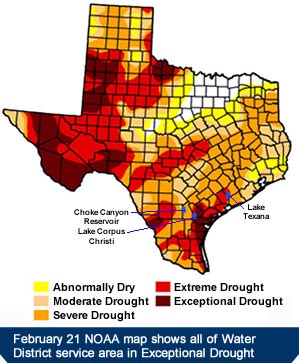Lake Texana Rebounds; Choke Canyon/Lake Corpus Christi Inching Downward; La Niña Conditions Appear to be Easing
February 22, 2012
Rainfall associated with passing weather systems continues to raise lake levels at Lake Texana on the Navidad River. By Feb. 22nd the level had rebounded from a low of 35.7% of capacity at the beginning of the year to 78.5% and was continuing to rise.
 Water sales restrictions from Lake Texana which had been imposed in September have now been lifted.
Water sales restrictions from Lake Texana which had been imposed in September have now been lifted.
There have been minor rainfall events and small inflows into Choke Canyon Reservoir and Lake Corpus Christi since the first of the year. Their levels have inched down only slightly during the past 45 days. The total amount of water in storage in the system as of Feb. 22nd was 52.5% of total combined capacity.
The year-long Texas drought shows signs of weakening in north and east regions and things have improved somewhat in South Texas. The Water District service area in San Patricio and Aransas Counties remains in exceptional drought conditions, the most severe category.
Texas weather has been strongly impacted by persistent La Niña conditions in the Pacific. The most recent forecast from the Climate Prediction Center expects a transition from La Niña to more neutral conditions during the March to May time frame. An El Nino condition is expected in the eastern equatorial Pacific by the end of May and that could mean that South Texas could return to a more normal climate regime with greater likelihood of rainfall in the months ahead.
Outdoor burn bans have been lifted for San Patricio and Nueces Counties but remain in effect in surrounding areas. Soil moisture conditions have improved somewhat in the area and row crop farmers continue to monitor it as they make critical planting decisions for the 2012 season. Pasture conditions are still poor and some stock ponds remain empty.
The regional water supply system made up of Lake Corpus Christi, Choke Canyon Reservoir and contract water from Lake Texana is managed by the City of Corpus Christi. The city's Water Resources Advisory Committee had several discussions in recent months about the possibility of recommending adoption of stricter water use restrictions as part of the Drought Management Plan that applies to the entire region including customers of the San Patricio Municipal Water District. By mid-February city officials had declared that such restrictions were unnecessary and would not be brought forward at this time.
The current Drought Management Plan is triggered when the combined amount of water in storage in Choke Canyon and Lake Corpus Christi drops below 50%. This trigger was adopted before water from Lake Texana became available in 1998. The region has been buying up to 53,800 acre feet of water a year from Lake Texana and the Water District gets about half of its raw water from that source.
A change to the Drought Management Plan is being discussed which would account for the water available from Lake Texana in the calculation of the 50% trigger. That would have the effect of delaying the start of each of the three increasingly restrictive sets of water use rules.
DROUGHT WATER RULES
Triggers are activated at 50%, 40% and 30% of system storage capacity. When the reservoir system storage drops below 50% of total system capacity, local water provider are to issue a public notice to inform water users to take greater voluntary conservation measures.
When capacity drops to 40% water providers will implement mandatory restrictions including time of day outdoor watering restrictions. Residents and businesses will be restricted from using water for irrigation of vegetation between the hours of 10:00 a.m. and 6:00 p.m. Under the 40% restrictions no person may: (1) allow water to run off from yards or plants into gutters or streets, (2) allow defective plumbing in a home or business to remain unaddressed or (3) allow water to flow constantly through a tap, hydrant, valve, or otherwise by any user of water connected to the municipal system. At 30% of reservoir capacity residential lawn watering will be sharply restricted to specific days in an effort to reduce demand further.








